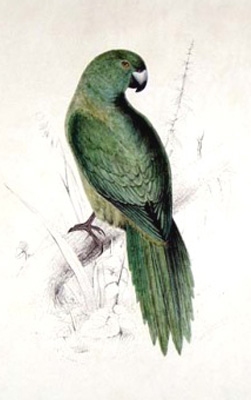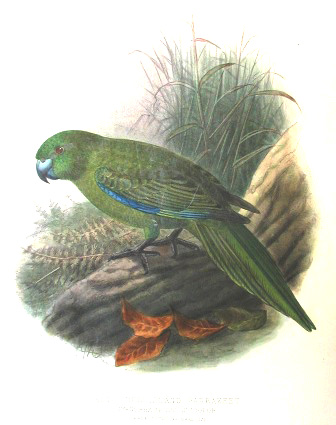


Lear, Edward, Illustrations of the Family of Psittacidae, 1832.
T he largest of the genus, the Antipodes Island parakeet was described as far back as 1831 from a specimen that had been taken to England alive and placed in the Zoological Society’s gardens. After it died, the skin was preserved in the British Museum. According to Oliver, it was this bird which Edward Lear portrayed in his famous folio monograph published in 1832, Illustrations of the Family of Psittacidae, or Parrots: the greater part of them species hitherto unfigured.
The locality from which the specimen had come was not recorded. In March, 1886, however, it was rediscovered by Captain Fairchild of the government steamer Stella, at Antipodes Island. On a later visit, the crew obtained a number of them and brought them to the mainland alive. They were apparently easily run down and caught by hand. Buller related how readily they took to confinement even though captured as adults.
The Antipodes Island — a mere rock in the ocean, 640 miles from Port Chalmers, New Zealand, in a southerly direction — is the only known spot on the face of the globe inhabited by this parakeet. It is common on the main island (20 km) and Bollons Island (0.5 km), and occurs in small numbers on Leeward (0.1 km), Inner Windward (0.1 km) and Archway (0.1 km) islets. In 1978, the population was estimated at 2,000-3,000 birds. Population trends are unknown, but numbers are likely to be stable.
It is found throughout the island habitats, but is most common in the tall, tussock grassland and sedges. These plants form the main part of the diet, supplemented with seeds, berries and flowers. They are also known to fossick around the colonies of rockhopper and erect-crested penguins for scraps of fat left on skua killed penguin and petrel carcasses. It nests in underground burrows, often more than one metre long, in tussock or sedge. In captivity, clutch-size is between five to six, but only one to three fledged young are generally seen with adults in the wild. Young probably start breeding at one year. Birds may be quite long–lived — two recaptures from Antipodes Island were at least 10 years old.
Accidental introduction of predators such as rats, cats and mustelids, is a potential threat. The Antipodes Islands are nature reserves, and landing is strictly by permit only. In 1907, 12 birds were released on Kapiti Island. They survived for around 20 years. The species is held widely in private aviaries and adapts readily to captivity. A captive management plan is in place to safeguard the species.


Buller, Walter Lawry, Supplement to the Birds of New Zealand, 1905.
| Taxonomy | |
|---|---|
| Kingdom: | Animalia |
| Phylum: | Chordata |
| Class: | Aves |
| Order: | Procellariiformes |
| Family: | Psittacidae |
| Genera: | Cyanoramphus |
| Species: | unicolor |
| Sub Species: |
Antipodean kakariki
Endemic bird
32 cm., females 29 cm., 130 g., plump, almost all-green parrot, green head, body with blue wing-coverts, and some flight feathers. Voice: wide range of chattering calls, lower-pitched than other Cyanoramphus species.
Antipodes Islands. There are a number of these birds in captivity.
Lear, Edward, Illustrations of the Family of Psittacidae, 1832.
Buller, Walter Lawry, Supplement to the Birds of New Zealand, 1905.
Buller, Walter Lawry, Supplement to the Birds of New Zealand, 1905.
Oliver, W.R.B., New Zealand Birds, 1955.
Sunday, 13 August, 2023; ver2023v1